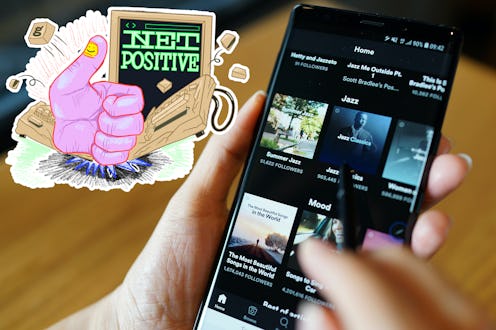Welcome to Net Positive, a series about nice places and things on the world wide web.
Everyone agrees that Spotify has had an apocalyptic impact on the music industry: the 12-cent royalty checks, the two-hour Drake albums, the fact that “Heat Waves” is still somehow in the Billboard Top 10 due to the gluttonous power of algorithm-weaned playlists that pump the song directly into the speakers of countless H&Ms across the country. The record business wasn’t exactly known for its morals in the pre-Cloud age, but the feral desperation unleashed by the streaming overlords has brought us into uncharted territory — a world where labels must jostle for position on curations called “Ultimate Indie.”
All of this makes me miss the days of scrolling through the trenches of Limewire, risking the basic integrity of the family PC with every alleged Eminem file. You never really knew what you were downloading at the zenith of the MP3 revolution, which is a lost tradition when music corporations have shaved down our taste into a constellation of sterile data points.
However, there is still one way Spotify manages to recreate the wondrous unpredictability of mid-2000s music consumption, and it can be found when you accidentally double-click on, say, the Children of Bodom cover of “Danger Zone.”
That cover, one of the many “Danger Zone” takes on Spotify, is one of the funniest things I’ve ever heard. Children of Bodom was a power metal institution out in Finland, which is to say that every one of the band’s albums features a Grim Reaper on the sleeve. I typically seek out “Danger Zone” out of curdled mordancy or two-beer sincerity, so when I was first blindsided by the Bodom death-growl instead of the Kenny Loggins tenor one particularly wistful Friday night, I laughed so hard I almost fell out of my chair. I had reached deep into the benthic regions of the global pop music database and dredged up an incredible artifact that somehow fit the keywords I was searching for. Truly, there is no euphoria like stumbling into a weird Spotify cover.
My “Danger Zone” experience is only the tip of the iceberg. The music streaming model is essentially an attempt to archive every single song that’s ever been recorded — from triple-platinum BTS hits to staticky demos from your cousin’s garage band — into one accessible repository. That philosophy flattens out the SEO playing field towards infinity, which means you and I might find ourselves listening to a god-awful metalcore cover of “Blank Space” with one errant flick of the thumb. Yes, Spotify has served me up plenty of covers that I adore without any pretense whatsoever — a killer Girlpool take, a regal version of “Higher Love,” and a mind-bending reinvention of a Blawan techno classic into an ass-kicking post-punk banger — but there are also plenty of thirsty royalty-miners in the mix, a whole cottage industry of musicians eager to feast on the residual misclicks. (This “Good 4 U” remix, good lord.)
Sometimes I’ll type a song name into Spotify and build an impromptu playlist with whatever comes up — a slew of covers, radio edits, and extended mixes, presented in a vast array of quality, sincerity, and visibility. You see it all at once, glittering in the void. Struggle rappers adding their own verses to Migos songs, aging Warped Tour veterans squeezing whatever juice they can out of a Doja Cat banger, teenagers making a go at virality with their favorite Paramore jams. This is what I miss, man. Give me that old, weird digital music banquet, like an iTunes library filled to the brim with mislabeled Weird Al Yankovic songs. The streaming giants have tried to break down our consumption patterns into a math problem — something that can be solved with a rubric — but if you know where to look, you can still slip past the margins and into the wild underbelly of the record industry. I cannot guarantee that what you’ll find will be good, but you will not forget the Vitamin String Quartet’s reworking of “Semi-Charmed Life” anytime soon.
Children of Bodom recorded its “Danger Zone” cover in 2015, on what turned out to be the group’s penultimate album together. I like to imagine the track arriving right as the principal members entered their confusing middle years; perhaps at an age where the Grim Reaper seemed a little less cool. I picture the band granting themselves the privilege of being embarrassing and Dad-like, breaking with all the death metal trappings to indulge in what makes them the happiest — specifically, whatever was popular in 1986. I relate to that. I just turned 31, which means I am experiencing my first brushes with what it means to be washed. The Pitchfork reviews are whooshing by at an alarming degree, and my personal context continues to deteriorate as I rely on whatever I was listening to 10 years ago. It can be so humiliating to tell Spotify our desires. But as long as those covers keep populating in the search results, we’ll never be alone.
Luke Winkie is a writer in Brooklyn.
